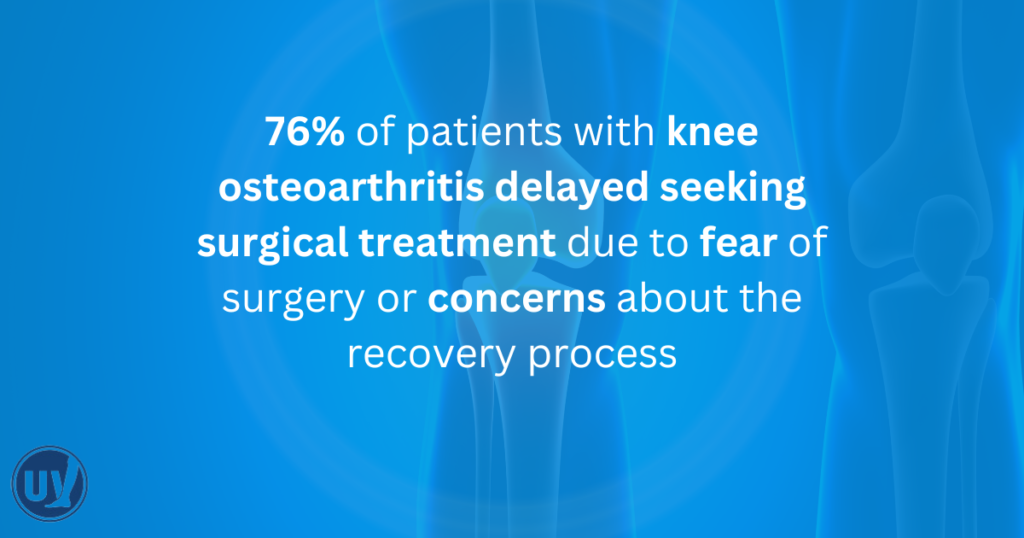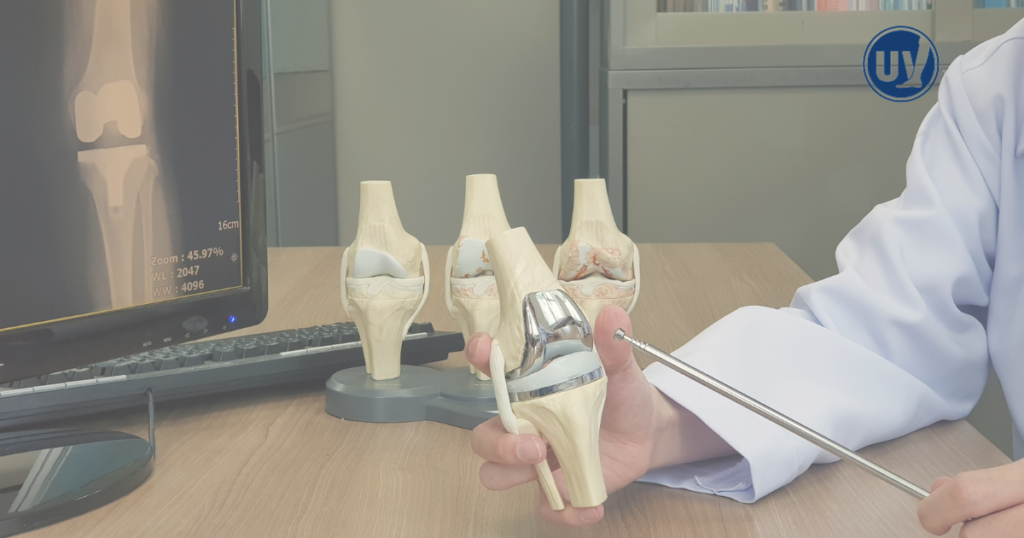Are you one of the millions of people suffering from knee osteoarthritis, desperate for relief but seeking minimally-invasive alternatives to avoid knee replacement surgery?
Groundbreaking non-surgical treatments are offering new hope for those seeking to avoid the risks and lengthy recovery associated with traditional knee surgeries.
It’s time to take control of your knee pain and reclaim your quality of life and learn how to avoid knee placement surgery.
What are Non-Surgical Treatments for Knee Osteoarthritis?
As the prevalence of knee osteoarthritis continues to rise, particularly among aging populations, the demand for effective non-surgical treatments has never been greater.
Despite the high incidence of knee osteoarthritis, many patients are hesitant to undergo total knee replacement surgery due to concerns about the invasive nature of the procedure, potential complications, and lengthy recovery times.

The Limitations of Traditional Conservative Treatments
Traditional conservative treatments for knee osteoarthritis, such as physical therapy, weight management, and pain medication, can provide some relief but often fail to address the underlying causes of the condition.
Genicular Artery Embolization (GAE): A Revolutionary Alternative to Knee Replacement
In the quest for effective non-surgical treatments for knee osteoarthritis, Genicular Artery Embolization (GAE) has emerged as a groundbreaking alternative to traditional knee replacement surgery. This minimally invasive procedure offers hope to those seeking relief from chronic knee pain without the risks and lengthy recovery associated with joint replacement.
How Genicular Artery Embolization Works
Genicular Artery Embolization is performed by inserting a thin catheter through a small incision in the groin or wrist, which is then guided to the genicular arteries supplying blood to the inflamed synovium in the knee joint. Once in place, tiny particles are injected to reduce blood flow to the affected area, thereby decreasing inflammation and pain while improving overall joint function.
Benefits of Genicular Artery Embolization over Knee Replacement
One of the most significant advantages of Genicular Artery Embolization is its non-surgical nature. As an outpatient procedure, patients can expect a shorter recovery time compared to the lengthy rehabilitation required after knee replacement surgery. Additionally, GAE preserves the natural knee joint and range of motion, allowing patients to maintain a more active lifestyle post-treatment. The genicular artery embolization side effects are often little to none at all. Studies have shown that GAE carries a lower risk of complications compared to knee replacement surgery, with a complication rate of approximately 2.4% compared to 4.2% for knee replacement.
Ideal Candidates for GAE
GAE is particularly suitable for patients with moderate to severe knee osteoarthritis who have not responded well to conservative treatments such as physical therapy, medications, or injections. It is also an attractive option for individuals seeking to avoid or delay knee replacement surgery due to age, health concerns, or personal preferences. The success rate of genicular artery embolization has been reported to be around 70-80% in reducing pain and improving joint function.
Platelet-Rich Plasma (PRP) Therapy: Harnessing the Body’s Healing Potential for Knee Pain Relief
How PRP Therapy Works
PRP therapy involves taking a small blood sample from the patient and processing it to concentrate the platelets. The platelet-rich plasma is then injected directly into the affected knee joint. Platelets contain growth factors that promote tissue repair, reduce inflammation, and stimulate the production of new, healthy cells.
The procedure is performed in a medical office setting and typically takes less than an hour. The patient’s blood is drawn and placed in a centrifuge, which separates the platelets from other blood components. The concentrated platelet-rich plasma is then prepared for injection into the knee joint under ultrasound guidance to ensure precise placement.
Candidates for PRP Therapy
PRP therapy may be an appropriate treatment option for patients with mild to moderate knee osteoarthritis who have not found relief through conservative measures such as physical therapy, weight loss, and pain medications.
Radiofrequency Ablation (RFA): Targeted Pain Relief for Knee Osteoarthritis
How Radiofrequency Ablation Works
Radiofrequency ablation for knee osteoarthritis involves using a specialized needle to deliver radiofrequency energy to the genicular nerves, which are responsible for transmitting pain signals from the affected knee joint to the brain. The heat generated by the RF energy disrupts these pain signals, effectively reducing or eliminating pain in the treated area.
The procedure is performed under local anesthesia and guidance from X-ray or ultrasound imaging to ensure precise targeting of the nerves. A small probe is inserted near the genicular nerves, and once in place, the RF energy is delivered for a brief period, usually 90 seconds to 2 minutes per nerve.
Candidates for Radiofrequency Ablation
Patients with chronic knee pain caused by osteoarthritis who have not found adequate relief through more conservative treatments may be good candidates for RFA. The procedure is generally recommended for those who:
- Have had knee pain for at least 3 months
- Experience pain on most days of the month
- Have not responded well to medications, physical therapy, or injections
- Wish to avoid or delay knee replacement surgery

Comparing Non-Surgical Treatments: Which is Right for You?
Patients with knee osteoarthritis have several non-surgical treatment options to choose from. Each treatment has its own benefits and limitations, and the right choice depends on your individual needs and circumstances.
Factors to Consider When Choosing a Non-Surgical Treatment
When deciding on a non-surgical treatment for knee osteoarthritis, there are several important factors to keep in mind:
- Severity of knee osteoarthritis and symptoms: The stage of your osteoarthritis and the intensity of your pain and mobility issues will influence which treatments are most appropriate.
- Patient’s age, overall health, and treatment goals: Your age, general health status, and what you hope to achieve with treatment (e.g., pain relief, improved function) will also guide your decision.
- Availability and cost of treatments in your area: Some non-surgical options may not be widely available or covered by insurance, so it’s important to consider accessibility and affordability.
Consult with an Osteoarthritis Doctor
To determine the best non-surgical treatment for your knee osteoarthritis, it’s crucial to work closely with a doctor who specializes in this condition.
Embrace the Future of Knee Pain Relief
Knee osteoarthritis no longer means inevitable joint replacement surgery. Minimally invasive procedures harness the body’s natural healing potential, providing effective pain relief and improved joint function with shorter recovery times and fewer risks than traditional surgery.
As an osteoarthritis sufferer, you now have the power to take control of your treatment journey. By partnering with an experienced osteoarthritis doctor, you can explore these innovative options and create a personalized plan that aligns with your unique needs and goals. Don’t let knee pain hold you back any longer – the future of osteoarthritis treatment is here.
Take the first step towards a life free from knee pain and schedule a consultation at United Knee & Vascular Centers today!
Frequently Asked Questions
To avoid knee replacement surgery, patients should consider minimally invasive treatments such as Genicular Artery Embolization (GAE) to help alleviate pain associated with knee osteoarthritis. GAE targets the blood vessels that supply the knee joint, reducing pain and inflammation by disrupting the abnormal blood flow associated with arthritis. This approach can relieve symptoms and improve knee function without the need for major surgery. Chat with your doctor today about the benefits of GAE.
To help avoid knee replacement, focus on exercises that enhance knee mobility and strength. Incorporate stretching to improve flexibility, strengthening exercises to build the muscles around the knees, and range of motion exercises to gradually increase flexibility and movement. A balanced routine addressing these areas can help maintain knee function and reduce the need for surgery.
Possible side effects of Genicular Artery Embolization (GAE) can include temporary pain or swelling, bruising at the insertion site, and minimal bleeding. Most side effects are mild and resolve on their own within a few hours to days. Schedule your consultation today to see if GAE is right for you.

